This Special Release on Business Process Management (BPM) is based on the special tabulation of the 2015 Annual Survey of Philippine Business and Industry (ASPBI) final results for all employment sizes in Information and Communication and Administrative and Support Service Activities sectors. BPM industries are determined by these two sectors of the economy.
Computer programming activities leads the BPM industries in terms of number of establishments
In 2015, more than a third (36.3%) of the total BPM establishments (1,493 establishments) in the country were engaged in computer programming activities numbering to 542 establishments. Customer relationship management activities and sales and marketing (including telemarketing) followed with 320 establishments or 21.4 percent and 145 establishments or 9.7 percent, respectively. Figure 1 shows the distribution of establishment by industry sub-class in 2015.
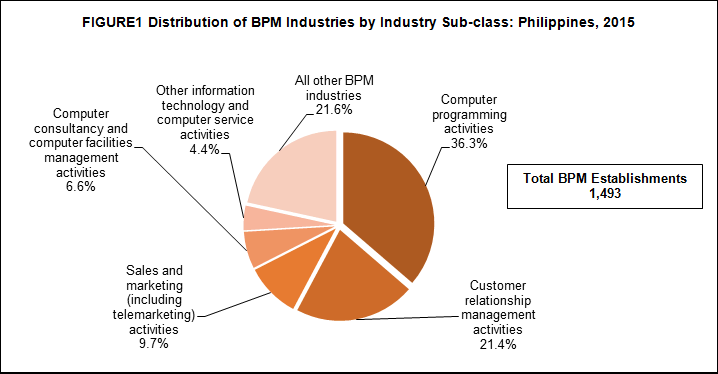
Majority of the jobs is in customer relationship management activities
BPM industries recorded a total of 573,221 workers in 2015. Customer relationship management activities reported 390,799 workers which is more than two-thirds (68.2%) of the total BPM workforce. Establishments engaged in sales and marketing (including telemarketing) activities followed with 72,546 (12.7%) workers. Computer programming activities placed third with 39,503 (6.9%) workers. Figure 2 shows the distribution of employment by BPM industries.
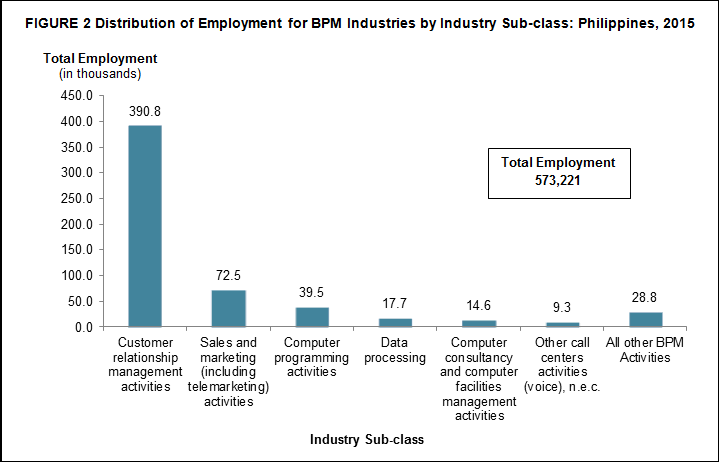
Finance and accounting activities has the highest annual pay per employee
BPM industries paid a total compensation of PHP239.5 billion in 2015 which is equivalent to an average annual compensation of PHP417,981 per employee. Across the BPM industries, customer relationship management activities recorded the highest total compensation paid amounting to PHP154.8 billion which is almost two-thirds (64.6%) of the total compensation paid for all employees of BPM industries. Sales and marketing (including telemarketing) activities placed a far second with a total compensation of PHP27.2 billion (11.4%) followed by computer programming activities with total compensation of PHP25.5 billion (10.7%).
Finance and accounting activities reported the highest average annual compensation per employee amounting to PHP922.0 thousand. This was followed by workers in payroll maintenance and other transaction processing activities with PHP779.1 thousand as average annual compensation. Document processes activities recorded the lowest average annual compensation per employee of PHP99.7 thousand. Figure 3 shows the average annual compensation of the top five BPM industries.

Customer relationship management activities tops in income and expense
In 2015, the BPM industries generated a total income of PHP461.4 billion. Customer relationship management activities earned the highest comprising more than half (57.3%) of the total income of the sector or about PHP264.4 billion. Computer programming activities came far next with a total income of PHP62.7 billion (13.6%) followed by sales and marketing (including telemarketing) activities with PHP51.3 billion (11.1%).
The total expense incurred by BPM industries amounted to PHP412.5 billion. Among BPM-related industries, customer relationship management activities spent the highest with PHP235.7 billion (57.1%). Figure 4 shows the top five BPM industries in terms of total income and expense.
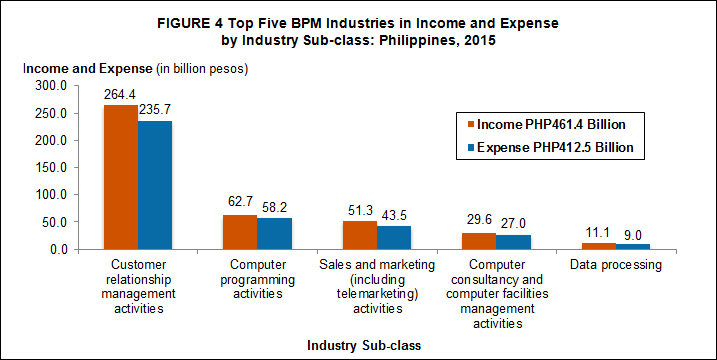
Income per peso expense is PHP1.12
The BPM industries recorded a ratio of PHP1.12 for income per peso expense in 2015. This means, that in 2015, the BPM industries earned PHP1.12 for every peso spent. Industrywise, the application hosting services registered the highest income per peso expense ratio of PHP1.65. Data processing placed second with PHP1.24 and sales and marketing (including telemarketing) activities ranked third with PHP1.18.
Labor productivity stands at an annual average of PHP535.2 thousand
Labor productivity (value added per worker) in BPM industries stood at an annual average of PHP 535.2 thousand in 2015. The highest labor productivity was generated by the payroll maintenance and other transaction processing activities which amounted to PHP1.5 million per worker. Application hosting services and finance and accounting activities both posted more than PHP1.3 million worth of labor productivity per worker. Figure 5 displays the labor productivity of the top five BPM industries.
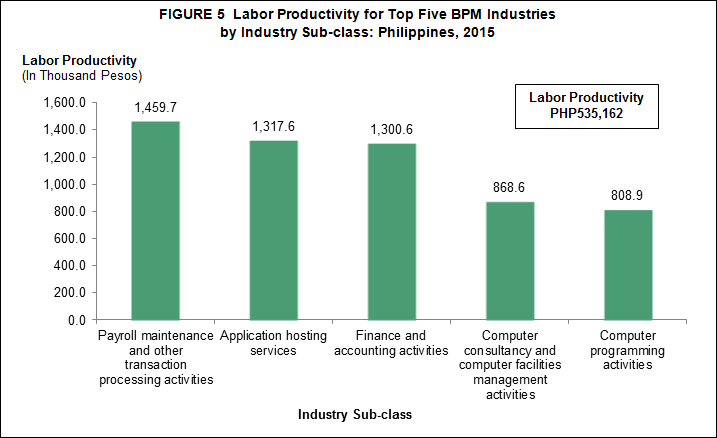
Gross additions to fixed asset totals PHP12.5 billion
The gross additions to fixed assets (capital expenditures less sale of fixed assets) of the BPM industries totaled to PHP12.5 billion. Customer relationship management activities recorded the highest gross additions to fixed assets among the BPM activities with PHP8.1 billion, accounting for 65.1 percent of the total for the sector. Sales and marketing (including telemarketing) activities followed next with PHP2.1 billion or 17.1 percent. Computer programming activities placed third with PHP849.3 million (6.8%).
BPM industries receive PHP136.7 million subsidies
Subsidies are special grants received from the government in the form of financial assistance or tax exemption or tax privilege to aid and develop an industry. The government granted a total of PHP136.7 million subsidies to the BPM industries in 2015.
Sales and marketing (including telemarketing) activities, customer relationship management activities, other information technology and computer service activities, and other back office operations activities, n.e.c. received subsidies of PHP106.5 million, PHP14.3 million, PHP8.4 million, and PHP7.6 million, respectively.
Computer consultancy and computer facilities management activities posts the highest change in inventories
Change in inventories is defined as the value of ending less beginning inventory. In 2015, the change in inventories of the BPM industries amounted to negative PHP79.8 million. Among industries, computer consultancy and computer facilities management activities recorded the highest positive change with PHP6.2 million. Other industries which reported positive change in inventories were application hosting services, finance and accounting activities, other information technology and computer service activities, engineering outsourcing activities, other publishing activities, and other call centers activities (voice), n.e.c..
Most income from transactions outside the country comes from USA
In 2015, about PHP205.3 billion was earned by the BPM industries from transactions made outside the country. Across the globe, United States of America contributed the largest part of income, sharing PHP126.5 billion or more than three-fifths (61.6%) of the total income from transactions outside the country. This was followed a far by Netherlands, contributing PHP17.2 billion (8.4%). Figure 6 shows the distribution of income of BPM industries from transactions outside the country.
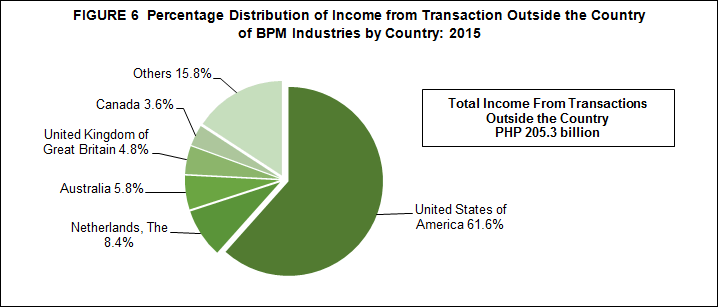
Income from transactions outside the country accounts for 44.5 percent of the total income of the industry
Income generated from transactions outside the country of BPM establishments was estimated at 44.5 percent of the total income of the industry. Customer relationship management activities, which consisted 68.1 percent (PHP139.9 billion) of the total income of the sector, recorded the highest income from transactions outside the country. This was followed a far by sales and marketing (including telemarketing) activities with 11.1 percent or PHP22.8 billion. In third place was computer programming activities that contributed 10.2 percent or PHP20.9 billion. Figure 7 shows the top five industries in terms of total income and income from transactions outside the country.
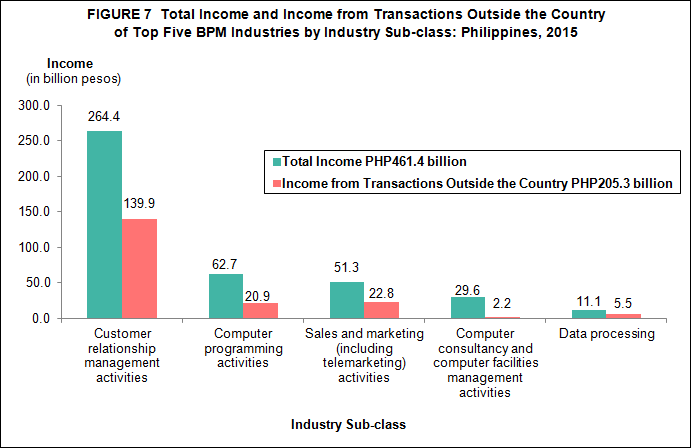
TECHNICAL NOTES
Scope and Coverage
The 2015 Annual Survey of Philippine Business and Industry (ASPBI) was conducted to collect information on the structure and trends of economic activities in the entire country for the year 2015. Covered were establishments engaged in economic activities as defined under the 2009 Philippine Standard Industrial Classification (PSIC).
These establishments were classified into 18 sectors, two of which are Information and Communication (Sector J) and Administrative and Support Service Activities (Sector N) which covered, among others, establishments engaged in Business Process Management (BPM) activities.
Response Rate
A total of 1,583 (88.88%) responded out of the 1,781 samples drawn for all BPM activities establishments. Out of the total receipts, 72 (4.04%) responded on-line.
Concepts and Definitions of Terms
Establishment - an economic unit which engages under a single ownership or control, i.e. under a single legal entity, in one or predominantly one kind of economic activity at a single fixed location. It is also defined as the unit that is engaged in the production of the most homogenous group of goods and services, usually at one location, sometimes over a wider area for which separate records are available that can provide data concerning the production of these goods and services and the materials, labor and physical resources used in the production.
Economic activity or business - is the activity of the establishment as classified under the 2009 Philippine Standard Industrial Classification (PSIC). The main activity refers to the activity that contributes the biggest or major portion of the gross income or revenue of the establishment.
Computer and related activities establishment – Office or firm engaged in hardware consultancy, software publishing, software development, data processing, database activities and on-line distribution of electronic content, maintenance and repair of office, accounting and computing machinery and others.
Miscellaneous business activities establishment – Office or firm engaged in legal, accounting, bookkeeping and auditing; tax consultancy; market research and public opinion polling; business and management consultancy; architectural and engineering activities; land surveying services; technical and testing analysis; advertising; labor recruitment and provision of personnel; investigation and security services; cleaning of buildings of all types; pest control services; industrial cleaning activities; photographic activities; packaging activities; management and administrative services; bill collecting and credit rating services; business brokerage; stenographic, duplicating and mailing activities; fashion design; interior decoration services; call center activities; medical transcription and others.
Business Process Outsourcing (BPO) is the leveraging of technology or specialist process vendors to provide and manage an organization’s critical and/or non-critical enterprise processes and applications.
Outsourcing (or contracting out) is the delegation of non-core operations or jobs from internal production within a business to an external entity (such as a subcontractor) that specializes in that operation. Outsourcing is done to save money, improve quality, or free company resources for other activities. Outsourcing was first done in the data-processing industry and has spread to areas, including telemessaging and call centers.
Offshore outsourcing is the practice of hiring an external organization to perform some or all business functions in a country other than the one where the product or service will be sold or consumed.
Computer consultancy and computer facilities management activities includes planning and designing of computer systems that integrate computer hardware, software and communication technologies
Software Publishing includes publishing of ready-made (non-customized) software: operating systems, business and other applications, computer games for all platforms
Computer programming activities includes the activities of writing, modifying, testing, and supporting software, designing the structure and content of, and/or writing the computer code necessary to create and implement: systems software (including updates and patches), software applications (including updates and patches), databases, web pages; customizing of software, i.e.modifying and configuring an existing application so that it is functional within the client's information system environment
Database Activities and On-line Distribution of Electronic Content some of the activities included in this group are compilation of data from one or more sources, on-line data base publishing, internet search sites ,,electronic learning are examples of the activities undertaken
Other Computer Related Activities includes computer disaster recovery, software installation services
Call centers activities (Voice) includes inbound call centers, answering calls from clients by using human operators, automatic call distribution, computer telephone integration, interactive voice response systems or similar methods to receive orders, provide product information, deal with customer request for assistance or address customer complaints; outbound call centers using similar methods to sell or market goods or services to potential customers, undertake market research or public opinion polling and similar activities for clients
Motion picture, video and television programme activities and post-production activities includes production of theatrical and non-theatrical motion pictures whether on film, video tape, DVD or other media, including digital distribution, for direct projection in theatres or for broadcasting on television; supporting activities such as film editing, cutting, dubbing etc.; distribution of motion pictures or other film productions (video tapes, DVD's etc.) to other industries; as well as their projection. Buying and selling of motion picture or any other film production distribution rights is also included. It also includes production of motion pictures, videos, television programmes or television commercials. Post production activities such as: editing, film/tape transfers, titling, subtitling, credits closed captioning, computer-produced graphics, animation and special effects film/tape transfers Activities of motion pictures film laboratories and activities of special laboratories for animated films: developing and processing motion picture film, activities of motion picture film, reproduction of motion picture film for theatrical distribution
Total Employment - is the number of persons who worked in or for the establishment as of November 15, 2014.
Paid employees - are persons working in the establishment receiving regular pay as well as those working away from the establishment when paid by and under the control of the establishment. Included are persons working as full-time or part-time and those employees on sick leave, paid vacation or holiday. Excluded are consultants, home workers and workers receiving commission only.
Unpaid workers - include working owners who do not receive regular pay, apprentices and learners without regular pay, and persons working without regular pay for at least one third of the working time normal to the establishment
Compensation – is the sum of salaries and wages; separation, retirement, terminal pay, gratuities and others; and employer’s contribution to SSS, GSIS, etc.
Salaries and wages – are gross payments made by establishments to its employees in cash or in kind, that is, prior to deduction for employee’s contribution to SSS/GSIS, withholding tax, etc. Included are total basic pay; vacation, sick and maternity leave pay; overtime pay and other benefits.
Employer’s contribution to SSS, GSIS, etc. – includes contribution to Employees Compensation Commission (ECC), Philhealth, PAG-IBIG, etc.
Income - refers to cash received and receivables for goods/products and by-products sold and services rendered.
Expense - refers to cost incurred by the establishment during the year whether paid or payable. This is treated on a consumed basis.
Fixed assets - are physical assets expected to have productive life of more than one year and intended for use and/or being used by the establishment. Included are land, buildings, fixtures, machinery, tool, furniture, office equipment, vehicles, and the like.
Gross additions to fixed assets - refer to the difference between the cost of acquisition of fixed assets acquired in 2012 and the value of sales of fixed assets during the year.
Capital expenditures - refer to the cost of acquisition of fixed assets acquired in 2012 whether or not full payments have been made.
Change in inventories - is equivalent to the value of inventories at the end of the year less the value of inventories at the beginning of the year.
Inventories - refer to the stock of goods owned by and under the control of the establishment as of a fixed date, regardless of where the stocks are located. Valuation is at current replacement cost in purchaser prices. Replacement cost is the cost of an item in terms of its present price rather than its original cost.
Subsidies - are all special grants in the form of financial assistance or tax exemption or tax privilege given by the government to aid and develop an industry.
Valued added - is gross output less intermediate input. Gross output for information and communication is the sum of the total revenue (less interest income, rent income from land, dividend income, royalty income and franchise income), capital expenditures of fixed assets produced on own account and change in inventories. Intermediate input is equal to the sum of the following cost items: materials and supplies purchased; fuels, lubricants, oils and greases purchased; electricity purchased; water purchased; cost of industrial services done by others; cost of non-industrial services done by others; goods purchased for resale; research and development expense; environmental protection expense; royalty fee; franchise fee; payouts and other cost.
See more at the Annual Survey of Philippine Business and Industry main page.
